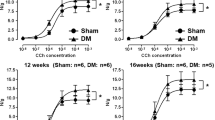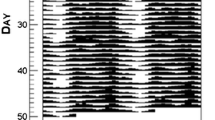Abstract
Objectives
To investigate time course of bladder dysfunction and concurrent changes in number and affinity of the muscarinic and P2X receptor in the early stage of streptozotocin (STZ)-induced diabetic rats.
Materials and methods
Diabetic rats were prepared by the intraperitoneal injection of 50 mg/kg of STZ to 7-week-old female Wistar rats. We performed recording of 24-h voiding behavior and cystometry at 1, 4, 8, and 12 weeks after the induction of diabetes. A muscle strip experiments with electrical field stimulation (EFS), carbachol, and α,β-methylene adenosine 5′-triphosphate (α,β-MeATP) were also performed at the same time-points. Additionally, concurrent changes in number and affinity of bladder muscarinic and P2X receptor were measured by a radioreceptor assay using [N-methyl-3H] scopolamine methyl chloride ([3H]NMS) and α,β-methylene-ATP (2,8-3H) tetrasodium salt ([3H]α,β-MeATP).
Results
In STZ-induced diabetic rats, polydipsic polyuric pollakiuria were noted on recording of 24-h voiding behavior from early stage. Also, the residual urine volume markedly increased in diabetic rats on cystometry. In the muscle strip experiment, the detrusor contractions induced by EFS, carbachol, and α,β-MeATP were enhanced in STZ-induced diabetic rats. Based on the radioreceptor assay, the maximum number of sites (Bmax) for the specific binding of [3H]NMS and [3H]α,β-MeATP was concurrently increased in the bladder from diabetic rats.
Conclusion
Increased bladder contractility is found in early stage of diabetic rats. Then, bladder dysfunction is associated with increased number of muscarinic and P2X receptors in STZ-induced diabetic rats.



Similar content being viewed by others
Abbreviations
- STZ:
-
Streptozotocin
- EFS:
-
Electrical field stimulation
- α,β-MeATP:
-
α,β-methylene adenosine 5′-triphosphate
- [3H]NMS:
-
[N-methyl-3H] scopolamine methyl chloride
- [3H]α,β-MeATP:
-
α,β-methylene-ATP (2,8-3H) tetrasodium salt
- Kd:
-
Dissociation constant
- Bmax:
-
Maximum number of sites
- NANC:
-
Non-adrenergic non-cholinergic
References
Frimodt-Moller C (1978) Diabetic cystopathy. A review of the urodynamic and clinical features of neurogenic bladder dysfunction in diabetes mellitus. Dan Med Bull 25(2):49–60
Ellenberg M (1980) Development of urinary bladder dysfunction in diabetes mellitus. Ann Intern Med 92(2 Pt 2):321–323
Kaplan SA, Te AE, Blaivas JG (1995) Urodynamic findings in patients with diabetic cystopathy. J Urol 153(2):342–344
Kebapci N, Yenilmez A, Efe B, Entok E, Demirustu C (2007) Bladder dysfunction in type 2 diabetic patients. Neurourol Urodyn 26(6):814–819. https://doi.org/10.1002/nau.20422
Christ GJ, Hsieh Y, Zhao WX, Schenk G, Venkateswarlu K, Wang HZ, Tar MT, Melman A (2006) Effects of streptozotocin-induced diabetes on bladder and erectile (dys)function in the same rat in vivo. BJU Int 97(5):1076–1082. https://doi.org/10.1111/j.1464-410X.2006.06058.x
Tong YC, Cheng JT, Hsu CT (2006) Alterations of M(2)-muscarinic receptor protein and mRNA expression in the urothelium and muscle layer of the streptozotocin-induced diabetic rat urinary bladder. Neurosci Lett 406(3):216–221. https://doi.org/10.1016/j.neulet.2006.07.065
Cheng JT, Yu BC, Tong YC (2007) Changes of M3-muscarinic receptor protein and mRNA expressions in the bladder urothelium and muscle layer of streptozotocin-induced diabetic rats. Neurosci Lett 423(1):1–5. https://doi.org/10.1016/j.neulet.2007.05.062
Saito M, Kinoshita Y, Satoh I, Shinbori C, Suzuki H, Yamada M, Watanabe T, Satoh K (2007) Ability of cyclohexenonic long-chain fatty alcohol to reverse diabetes-induced cystopathy in the rat. Eur Urol 51(2):479–487. https://doi.org/10.1016/j.eururo.2006.06.024 (discussion 487–478)
Malmgren A, Andersson PO, Uvelius B (1989) Bladder function in rats with short- and long-term diabetes; effects of age and muscarinic blockade. J Urol 142(6):1608–1614
Daneshgari F, Liu G, Imrey PB (2006) Time dependent changes in diabetic cystopathy in rats include compensated and decompensated bladder function. J Urol 176(1):380–386. https://doi.org/10.1016/S0022-5347(06)00582-9
Munoz A, Boone TB, Smith CP, Somogyi GT (2013) Diabetic plasticity of non-adrenergic non-cholinergic and P2X-mediated rat bladder contractions. Brain Res Bull 95:40–45. https://doi.org/10.1016/j.brainresbull.2013.03.006
Tong YC, Hung YC, Shinozuka K, Kunitomo M, Cheng JT (1997) Evidence of adenosine 5′-triphosphate release from nerve and P2X-purinoceptor mediated contraction during electrical stimulation of rat urinary bladder smooth muscle. J Urol 158(5):1973–1977. https://doi.org/10.1016/S0022-5347(01)64196-X
Andersson KE, Arner A (2004) Urinary bladder contraction and relaxation: physiology and pathophysiology. Physiol Rev 84(3):935–986. https://doi.org/10.1152/physrev.00038.2003
Lai HH, Smith CP, Munoz A, Boone TB, Szigeti GP, Somogyi GT (2008) Activation of cholinergic receptors blocks non-adrenergic non-cholinergic contractions in the rat urinary bladder. Brain Res Bull 77(6):420–426. https://doi.org/10.1016/j.brainresbull.2008.07.011
Cockayne DA, Hamilton SG, Zhu QM, Dunn PM, Zhong Y, Novakovic S, Malmberg AB, Cain G, Berson A, Kassotakis L, Hedley L, Lachnit WG, Burnstock G, McMahon SB, Ford AP (2000) Urinary bladder hyporeflexia and reduced pain-related behaviour in P2X3-deficient mice. Nature 407(6807):1011–1015. https://doi.org/10.1038/35039519
Lee WC, Chiang PH, Tain YL, Wu CC, Chuang YC (2012) Sensory dysfunction of bladder mucosa and bladder oversensitivity in a rat model of metabolic syndrome. PLoS ONE 7(9):e45578. https://doi.org/10.1371/journal.pone.0045578
Igawa Y, Persson K, Andersson KE, Uvelius B, Mattiasson A (1993) Facilitatory effect of vasoactive intestinal polypeptide on spinal and peripheral micturition reflex pathways in conscious rats with and without detrusor instability. J Urol 149(4):884–889
Nasrin S, Masuda E, Kugaya H, Ito Y, Yamada S (2013) Improvement by phytotherapeutic agent of detrusor overactivity, down-regulation of pharmacological receptors and urinary cytokines in rats with cyclophosphamide induced cystitis. J Urol 189(3):1123–1129. https://doi.org/10.1016/j.juro.2012.09.054
Liu G, Daneshgari F (2006) Temporal diabetes- and diuresis-induced remodeling of the urinary bladder in the rat. Am J Physiol Regul Integr Comp Physiol 291(3):R837–R843. https://doi.org/10.1152/ajpregu.00917.2005
Longhurst PA, Leggett RE, Briscoe JA (1995) Characterization of the functional muscarinic receptors in the rat urinary bladder. Br J Pharmacol 116(4):2279–2285
Vial C, Evans RJ (2000) P2X receptor expression in mouse urinary bladder and the requirement of P2X(1) receptors for functional P2X receptor responses in the mouse urinary bladder smooth muscle. Br J Pharmacol 131(7):1489–1495. https://doi.org/10.1038/sj.bjp.0703720
O’Reilly BA, Kosaka AH, Chang TK, Ford AP, Popert R, Rymer JM, McMahon SB (2001) A quantitative analysis of purinoceptor expression in human fetal and adult bladders. J Urol 165(5):1730–1734. https://doi.org/10.1016/S0022-5347(05)66403-8
Yoshida M, Homma Y, Inadome A, Yono M, Seshita H, Miyamoto Y, Murakami S, Kawabe K, Ueda S (2001) Age-related changes in cholinergic and purinergic neurotransmission in human isolated bladder smooth muscles. Exp Gerontol 36(1):99–109. https://doi.org/10.1016/S0531-5565(00)00175-3
Birder LA (2005) More than just a barrier: urothelium as a drug target for urinary bladder pain. Am J Physiol Renal Physiol 289(3):F489–F495. https://doi.org/10.1152/ajprenal.00467.2004
Ford AP, Gever JR, Nunn PA, Zhong Y, Cefalu JS, Dillon MP, Cockayne DA (2006) Purinoceptors as therapeutic targets for lower urinary tract dysfunction. Br J Pharmacol 147(Suppl 2):S132–S143. https://doi.org/10.1038/sj.bjp.0706637
Elbadawi A (1996) Functional anatomy of the organs of micturition. Urol Clin North Am 23(2):177–210
Chancellor MB (2014) The overactive bladder progression to underactive bladder hypothesis. Int Urol Nephrol 46(Suppl 1):S23–S27. https://doi.org/10.1007/s11255-014-0778-y
Torimoto K, Fraser MO, Hirao Y, De Groat WC, Chancellor MB, Yoshimura N (2004) Urethral dysfunction in diabetic rats. J Urol 171(5):1959–1964. https://doi.org/10.1097/01.ju.0000121283.92963.05
Torimoto K, Hirao Y, Matsuyoshi H, de Groat WC, Chancellor MB, Yoshimura N (2005) alpha1-Adrenergic mechanism in diabetic urethral dysfunction in rats. J Urol 173(3):1027–1032. https://doi.org/10.1097/01.ju.0000146268.45662.36
Yang Z, Dolber PC, Fraser MO (2007) Diabetic urethropathy compounds the effects of diabetic cystopathy. J Urol 178(5):2213–2219. https://doi.org/10.1016/j.juro.2007.06.042
Author information
Authors and Affiliations
Corresponding author
Ethics declarations
Conflict of interest
The authors declare that they have no conflict of interest.
Ethical approval
All animal experiments were approved by the Animal Research and Care Committee at the Nihon University School of Medicine (Approved No. 080139). This article does not contain any studies with human participants performed by any of the authors.
Rights and permissions
About this article
Cite this article
Yoshizawa, T., Hayashi, Y., Yoshida, A. et al. Concomitant alteration in number and affinity of P2X and muscarinic receptors are associated with bladder dysfunction in early stage of diabetic rats. Int Urol Nephrol 50, 451–458 (2018). https://doi.org/10.1007/s11255-018-1800-6
Received:
Accepted:
Published:
Issue Date:
DOI: https://doi.org/10.1007/s11255-018-1800-6




